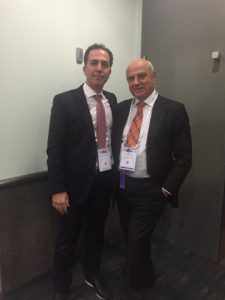NewVisions’ Dr. Noel Alpins attends prestigious industry conference in L.A.
Dr. Noel Alpins, an experienced cataract and refractive surgeon for NewVision Clinics, recently attended the ASCRS (American Society of Cataract and Refractive Surgery) meeting in Los Angeles, California, to talk with doctors and exhibitors and present two unique papers on laser surgery.
Alpins, a pioneer in laser eye surgery for astigmatism, has an ongoing commitment: teaching other ophthalmologists about how to treat this condition better.
“Astigmatism is a common condition of the eye, treated in 60 per cent of laser eye surgeries, where the cornea is more oval in shape rather than round causing blurring of the image on the retina,” Alpins explained.
“If people suffer from headaches or are easily tired from use of their eyes, then they should have them checked by an eye professional to see if this or other refractive errors are present.”
The veteran eye surgeon presented two papers on the podium: one on astigmatism treatment employing vector planning and the other on Corneal Topographic Astigmatism ( CorT) and how it relates and rates with tomographers—who actually measure astigmatism in the cornea.
“The numbers that we get with CorT are more accurate than the general numbers of total corneal power (TCP) and Simulated Keratometry (SimK) generated by the device,” Alpins acknowledged.
At the conference, which attracts 5000 attendees from all over the world, Alpins received an award for ‘Best Paper of Session’ (BPOS).
“Out of 20 papers, the chairman and co-panelists gave me this award for my paper on vector planning, which was very gratifying to receive,” he said.
Alpins also was on an ASCRS KOL panel for Zeiss, talking about extended depth of focus and trifocal implants, which is something new that is being released in the industry. In addition, he spoke at the Schwind trade exhibit booth, talking about their laser and how it could be improved with vector planning.
The Alpins vector planning method is a technology the renowned specialist has implemented for many years now, which minimises corneal astigmatism without compromising the refractive cylinder remaining. This leaves patients with a better shape of the cornea and therefore, a better vision outcome as a result, since the patient has to “wear” their cornea for the rest of their lives.
Next up for Alpins is his latest book, which consists of 24 chapters, called Practical Astigmatism, Planning and Analysis. The book will be published later this year by Slack Inc.
“Since the 1990s I have written over 20 peer reviewed papers on new techniques that plan and analyses astigmatism and CorT,” said Alpins. “Now that I have done all this research, I thought it was time to put these papers all under one book, making all the developments readily accessible so that people can pick it up and read the whole thing in an easily readable form. It shows how all these developments and studies all relate to each other, into one unified theme or method of astigmatism treatment and analysis.”
Alpins’ senior optometrist, Dr. George Stamatelatos, was on hand as well to talk with the manufacturers of tomographers and laser companies, and to chair and present at their 90-minute course on astigmatism management. At NewVision Clinics, Stamatelatos is clinical director of the surgical management software, which looks at analysing and planning the treatments they do with laser and incision cataract surgery.
“We have three full-time optometrists which is unique to the clinic and we do the workup with the patients and assist Dr. Alpins with all the pre and post operative procedure,” Stamatelatos noted.
For more information, contact NewVision Clinics on 1800 20 20 20.
Journalist byline: Susan Hornik is a veteran entertainment and lifestyle journalist based in Los Angeles. She writes regularly for the The Washington Times.


